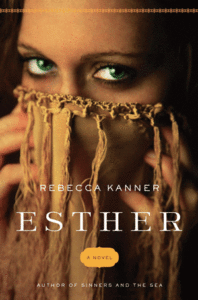Esther, by Rebecca Kanner, Howard Books, 380 pages, $22.99
Reviewed by NEAL GENDLER
If the Bible’s Book of Esther were a movie, it’d likely be rated PG, for parental guidance. Rebecca Kanner’s Esther would get an R or MA for violence and strong sexual suggestion.
Minnesota author Kanner, whose first novel, Sinners and the Sea, was an imaginative, if gruesome tale of Noah, now gives us her idea of how a young Jew named Hadassah — disguising herself as Esther — staved off three attempts on her life, fell for one of her kidnappers and kept Haman from killing the Jews of Persia.
It’s not a pretty picture.
The basic story is familiar to everyone who ever celebrated Purim, and Kanner does not venture far from it. But does she add!

Her Esther is one of scores of girls taken in a brutal roundup to replenish the king’s harem. Cousin Mordechai, 24, works in the palace as — what else — an accountant.
Kanner’s harem girls are cleaned, softened and overfed for a year, apparently drinking wine constantly, and sedated with opium. Then they await a summons to the king’s bed. Disfavor can sentence them to the king’s troops as sex slaves.
Esther, captured at the age of 14, is blessed with a wise, older servant, Ruti — also a secret Jew — and finds favor with head eunuch Hegai, who admires her dignity and courage. Hegai, who chooses the king’s nightly harem girl if one isn’t requested by name, decides he’ll get the king to make Esther the queen instead of the king’s favorite bedmate, the beautiful, evil Halannah.
But keeping Esther alive is an unending struggle in this splendid but sorry palace of scheming, envy, greed and drunkenness. Halannah, who is Haman’s niece, hates Esther at first sight. She tries to deflower Esther, then to kill her. Esther permanently loses full use of her right hand after grabbing a knife blade headed for her throat.
After that, Hagai elevates Esther to her own elegant chamber, with chambermaids, jewelry, special hairdos, and the title of mistress. Women gasp as Esther is called “Ishtar,” the name the king also uses — the name of the ancient goddess of sex and fertility.
The king finds Esther/Ishtar unlike the other women sent to him and quickly chooses her to be queen. But apparently this queen’s only role is awaiting the king’s infrequent summons and producing a son. Finally pregnant, Esther is poisoned into miscarriage and barrenness. She grieves at having to keep her identity hidden from all but Mordechai and Ruti, asking herself: “Why did it hurt me that people did not know who I was?”
The king’s most loyal soldier, Erez, knows; he was her kidnapper. Unlike the other raiders — led by Haman’s evil, oldest son Parsha — he showed her a drop of kindness, and eventually Esther becomes smitten with him. To prevent further attempts on Esther’s life, the unwitting king makes Erez her chief guard. Daily proximity adds to Esther’s despair; she only can sneak glances at him and dream of his touch.
We know how the story ends, but Kanner’s imagination precedes it with suffering, beatings, amputations, deaths and pain. She also follows it with something the Bible doesn’t: an epilogue suggesting Esther/Hadassah’s future.
Kanner has shortened the Bible’s Parshandahta, Haman’s cruel, Esther-hating oldest son, into Parsha, and uses Xerxes, historically accurate for the king we know as Achashrayrosh. He’s a physical giant but, as in the Bible, none too bright, impulsive and too easily influenced.
In this novel, Esther tells her own story. Kanner still has a little difficulty writing natural-sounding dialogue — not an easy task — but that fades from notice when she hits her stride in mid-book, producing a series of actions that pull the reader rapidly from page to page and makes Esther hard to put down.
***
Neal Gendler is a Minneapolis writer and editor.
(American Jewish World, 12.18.15)



















